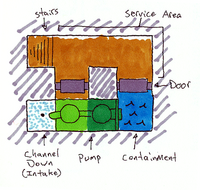- v50 information can now be added to pages in the main namespace. v0.47 information can still be found in the DF2014 namespace. See here for more details on the new versioning policy.
- Use this page to report any issues related to the migration.
Difference between revisions of "23a:Dwarven atom smasher"
(building destroyers have always ignored bridges) |
m |
||
| Line 1: | Line 1: | ||
| − | {{quality|Exceptional|20:22, 28 April 2011 (UTC)}}{{av}} | + | {{quality|Exceptional|20:22, 28 April 2011 (UTC)}} |
| + | {{projects}}{{av}} | ||
The '''Dwarven Atom Smasher''' is a euphemism for a [[Drawbridge]] in militarily-significant applications. It [[exploit]]s the implementation of drawbridges to utterly destroy any objects and most creatures in its target area. | The '''Dwarven Atom Smasher''' is a euphemism for a [[Drawbridge]] in militarily-significant applications. It [[exploit]]s the implementation of drawbridges to utterly destroy any objects and most creatures in its target area. | ||
Revision as of 10:56, 23 July 2013
| Part of a number of articles on |
| Projects |
|---|
| Basic |
| Aqueduct • Archery tower • Atom smasher • Danger room • Dam • Garbage dump • Mass pit • Moat • Pit trap • Reservoir• Sally port • Swimming pool • Tower • Tree farm |
| Advanced |
| Drowning chamber • Magma piston • Obsidian farm • Pump stack • Silk farm • Water reactor |
| This article is about an older version of DF. |
The Dwarven Atom Smasher is a euphemism for a Drawbridge in militarily-significant applications. It exploits the implementation of drawbridges to utterly destroy any objects and most creatures in its target area.
Smashing Against The Floor
In this design, a drawbridge is built to come down on at least one tile of solid floor. The drawbridge is raised, the targets move into position on that floor, and then the drawbridge is lowered, squashing the targets flat. In Dwarf Fortress, "squashed flat" is implemented as "erased from existence".
This is the most common design, since large areas (up to 5x10 - any larger would trigger a cave-in) can be affected per bridge; it's easy to create one big corridor of death and kill an entire goblin raiding party in one fell splat.
Smashing upon closing
In this design, a very compact drawbridge (as little as one tile long) is used, and the target area is the one-tile wide anchoring area, where the bridge will close. This often uses walls, locked doors, or other solid objects, leaving the targets nowhere to go. The drawbridge is lowered, the targets move into position on the tile(s) that the drawbridge will occupy when closing, and then the drawbridge is raised, squashing the targets flat.
